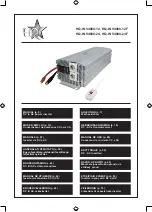
100544 - 7000W DUAL FUEL GENERATOR
OPERATION
19
!
WARNING
If there is a strong smell of LPG: Close valve on the cylinder.
Check all connections for leaks by wetting the fittings
with a solution of soap and water. Bubbles which appear
or bubbles which grow indicate that a leak exists. Do not
smoke or light a cigarette, or check for leaks using a match,
open flame source or lighter. Contact a qualified technician
to inspect and repair an LPG system if a leak is found,
before using the generator.
Grounding
Your generator must be properly connected to an appropriate
ground to help prevent electric shock.
!
WARNING
Failure to properly ground the generator can result in
electric shock.
A ground terminal connected to the frame of the generator has
been provided (see
Controls and Features
for terminal location).
For remote grounding, connect of a length of heavy gauge
(12 AWG minimum) copper wire between the generator ground
terminal and a copper rod driven into the ground. We strongly
recommend that you consult with a qualified electrician to
ensure compliance with local electrical codes.
OPERATION
Generator Location
NEVER operate the generator inside any building, including
garages, basements, crawlspaces and sheds, enclosure or
compartment, including the generator compartment of a
recreational vehicle. Please consult your local authority.
In some areas, generators must be registered with the local
utility. Generators used at construction sites may be subject
to additional rules and regulations. Generators should be on
a flat, level surface at all times. (Even while not in operation)
Generators must have at least 5 ft. (1.5 m) of clearance from
all combustible material. In addition to clearance from all
combustible material, generators must also have at least 3 ft.
(91.4 cm) of clearance on all sides to allow for adequate cooling,
maintenance and servicing. Generators should never be started
or operated in the back of a SUV, camper, trailer, in the bed of
a truck (regular, flat or otherwise), under staircases/stairwells,
next to walls or buildings, or in any other location that will not
allow for adequate cooling of the generator and/or the muffler.
DO NOT contain generators during operation. Allow generators
to properly cool before transport or storage.
Install battery-operated carbon monoxide alarms or plug-in
carbon monoxide alarms with battery back-up in your home
according to the manufacturer’s instructions.
Place the generator in a well-ventilated area. DO NOT place the
generator near vents or intakes where exhaust fumes could
be drawn into occupied or confined spaces. Carefully consider
wind and air currents when positioning generator.
Failure to follow proper safety precautions may void
manufacturer’s warranty.
!
WARNING
Do not operate or store the generator in rain, snow, or wet
weather.
Using a generator or electrical appliance in wet conditions,
such as rain or snow, or near a pool or sprinkler system,
or when your hands are wet, could result in electrocution.
!
WARNING
During operation the muffler and exhaust fumes produced
will become hot. If adequate cooling and breathing space
are not supplied, or if the generator is blocked or contained,
temperatures can become extremely heated and may lead
to fire.
Grounding*
A ground terminal connected to the frame of the generator has
been provided (see
Controls and Features
for terminal location).
Neutral Floating
–
Neutral circuit
IS NOT
electrically connected to the frame/
ground of the generator.
–
The generator (stator winding) is isolated from the frame
and from the AC receptacle ground pin.
–
Electrical devices that require a grounded receptacle pin
connection will not function if the receptacle ground pin is
not functional.
Neutral Bonded to Frame
















































